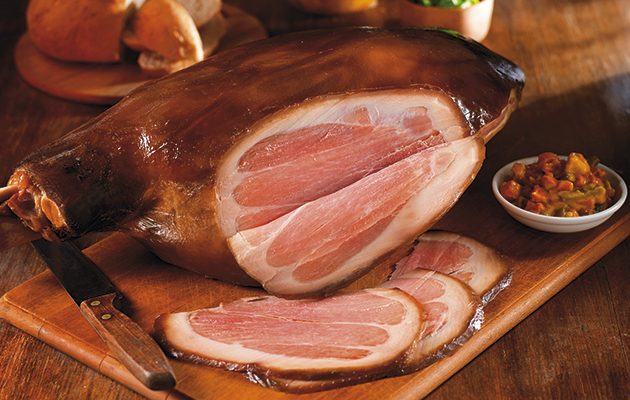Hattie Ellis is happy to be back in the pink with a Christmas ham on the winter table, whether smoked over lavender or cured in molasses and spices
If you have the family descending this Christmas, have a ham to hand. Gleaming and studded with cloves, a Christmas ham is excellent for the Christmas Eve supper, breakfast with eggs or even as a surreptitious late-night snack. Our festive favourite dates back to the Romans, as Hattie Ellis discovers. And, happily, you don’t need a vast pot to enjoy one at home this Christmas.
For more on the fascinating history behind the festive feast, read Stir-Up Sunday: stir up, we beseech thee for the history of the figgy pudding. It precedes many of our Victorian yuletide traditions, and has its origins in pottage. Though it is has come a long way since then.
CHRISTMAS HAM
One of the treats of the winter season is a whole Christmas ham, its gleaming coat studded with cloves. As family descend for bed and board, it’s good to have one on hand for suppers, lunch-time sandwiches, breakfast eggs and the odd sneaky slice to fill a corner late at night.
This British favourite dates back to the Romans and was embedded in our culture through the days when every cottager kept a pig, killed it in the autumn and preserved the hind legs for eating over winter. Different cures emerged, some regional, and many survive today. Scott’s of York, the last maker of the celebrated York Ham in the city, shut up shop in 2008, but other ham-makers are keeping up the old cures and adding new ones.
A ham, strictly speaking, is a hind leg taken off the pig and cured. A gammon comes off a carcass that has been salted for bacon and is milder. The best are given time to mature and take on and develop the flavours of their dry-salt mix or brine. Some cures use beer or cider; some are sweet and intense, such as the 18th-century Bradenham hams that use molasses and spices, the flavours of the West Indies. Hams can then be smoked for further flavour and “shelf life”.

Shropshire Blacks from Dukeshill, cured using juniper, black pepper and coriander, boneless half-ham.
Dukeshill in Shropshire makes a version of the Bradenham called a Shropshire Black, using juniper, black pepper and coriander among other flavours. Owner Neale Hollingsworth compares a real ham to a cheap one injected with water and protein softeners, tumbled into shape and moulded for uniform oval slices. “What you lose in terms of convenience you make up for in flavour, texture and all the other old-fashioned attributes,” he says.
Dukeshill’s biggest seller is now the boneless half-ham, made with part of the leg, but there’s still a good trade in the traditional sort. While the flavour is the same, bone in or out, Neale thinks the texture, as well as appearance, makes a whole ham a treat. “The bone holds it in a certain way as it cooks and keeps the meat tight, so it is slightly denser but more succulent,” he says.
PREPARING THE HAM AT HOME
While you can buy a whole cooked ham, how do you prepare one at home without a vast pot? Mark Thomas of Emmett’s in Suffolk advocates baking rather than boiling and gives a recipe on his website that includes honey and dried fruits to make an instant chutney sauce to eat alongside the meat. The company has been going since 1820 and still uses its original smokehouse. Thomas has continued the traditional Suffolk sweet cure using local beer, and has also tried out new ideas. He smokes some hams over Norfolk lavender and, after much experimentation, has produced a Christmas spiced ham that uses ginger, nutmeg, cinnamon, cloves, black pepper and star anise in its cure, along with brown sugar and molasses. The plan is to try elderflower for Easter.
One company with a range of traditional cures is Sandridge Farm in Wiltshire, a county with a long-standing pig tradition. Animals driven from Ireland to London took a break here and, from the 19th century, were spared the rest of the trip by the Harris family of Calne, who turned them into bacon. Once the factory closed, Sandridge was set up by the Keens, who now operate on an artisanal scale using cures developed from an old Farmers Weekly cookbook.
Tim Wilson, a new-wave farmer and butcher from Yorkshire-based Ginger Pig, delved into the same book. The company specialises in traditional pigs: the Tamworths that give the company its name, Gloucester Old Spots, Berkshires and British Lops. Ham-makers say a bit of fat helps the flavour, and these old-fashioned breeds have a good coating on them.
So which cures took off? People like the idea of a ham bathed in treacle but then buy something more familiar, explains Tim, whose ham sales have increased five-fold since he started experimenting.
Eminent food historian Ivan Day says historic recipes instruct you to take the skin off the ham, dust it with breadcrumbs and toast them with a salamander (a cooking iron heated up in a fire). Serving plates were then decorated in elaborate patterns of crumbs. What Ivan called a “fossil memory” of a sophisticated dish exists in the lurid orange crusts you find on ham in butchers and supermarket aisles today. The meat has been preserved, and so has its history.





